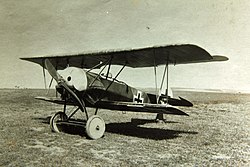Fokker D.VI
| Fokker D.VI | |
|---|---|

|
|
| Type: | Fighter plane |
| Design country: | |
| Manufacturer: | |
| First flight: |
1918 |
| Commissioning: |
April – August 1918 |
| Production time: |
1918 |
| Number of pieces: |
47 |
The Fokker D.VI was a fighter aircraft of the German Air Force and the Austro-Hungarian Aviation Troops from the First World War .
development
Based on the Fokker Dr.I three -decker , Reinhold Platz developed a cantilever, single- handled biplane without bracing with the factory designation V.9 as a successor model using the fuselage, tail unit, landing gear, engine and the same armament . Further developed for the V.13, two prototypes (V.13 / 1 and V.13 / 2) were built and presented at the fighter aircraft competition in January / February 1918 in Berlin-Adlershof. Both machines had rotary motors ; one the 145 hp UR III from the Oberursel engine factory , the other the 165 hp Siemens & Halske Sh.III . Fokker received a small production order, but the series machines were equipped with the more sophisticated UR II engine with 110 hp from Oberursel, a copy of the French Le Rhône engine. The striking difference to contemporary constructions was the use of a thick wing profile with a large nose radius and plywood planking. This resulted from the temporary merger of Fokker with Junkers, which was created under pressure from the military authorities, where Platz had got to know this construction principle. From then on, all further constructions of Platz had thick wing profiles and were potentially self-supporting. The prototype V.25 was z. B. a cantilevered low-wing aircraft based on the D.VI with an astonishingly modern appearance. And also Fokker's final construction EV / D VII I was very similar to the D.VI in terms of the shape of the fuselage.
commitment
Between April and August 1918, 47 Fokker D.VI with Oberursel UR.II engines and 12 machines with 160 hp Goebel Goe.III engines were delivered to Gandenberger's machine factory Georg Goebel, Darmstadt. Seven D.VI fighters were delivered to Austria-Hungary and equipped with 8 mm Schwarzlose MG and 150 HP Steyr-Le Rhône rotary engine (series 04.6 ..). Only a few machines reached German front-line units , as they were considered inferior to the Fokker D.VII in use, although the D.VI was very agile and faster than the D.VII in low-level flight. The aircraft were therefore mainly used for training.
Technical specifications
| Parameter | Data |
|---|---|
| crew | 1 |
| length | 6.23 m |
| span | 7.65 m |
| height | 2.55 m |
| Wing area | 17.70 m² |
| Empty mass | 393 kg |
| Takeoff mass | 583 kg |
| drive | an air-cooled rotary motor Oberursel UR II with 110 PS (81 kW) or Goebel Goe III with 160 PS (118 kW) |
| Top speed | 196 km / h above sea level |
| Climbing time to 1000 m | 2.30 min |
| Ascent time to 5000 m | 19 min |
| Service ceiling | 6000 m |
| Range | 300 km |
| Flight duration | 1.30 h |
| Armament | 2 synchronized MG 08/15 , cal. 7.92 mm |
See also
literature
- Reinhard Keimel : Austria's aircraft. History of aviation from its beginnings to the end of 1918. Weishaupt, Graz 1981, ISBN 3-900310-03-3 .
- Günter Kroschel, Helmut Stützer: The German military aircraft 1910–1918. Lohse-Eissing, Wilhelmshaven 1977, ISBN 3-920602-18-8 .
- Kenneth Munson: Bomber. Surveillance and reconnaissance aircraft. 1914-1919. Füssli, Zurich 1968, ( Airplanes of the World ).
- Heinz Nowarra: The Development of Airplanes 1914–1918. Lehmanns, Munich 1959.
Web links
Individual evidence
- ↑ Performance data can differ due to different engine types

